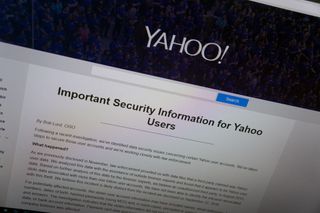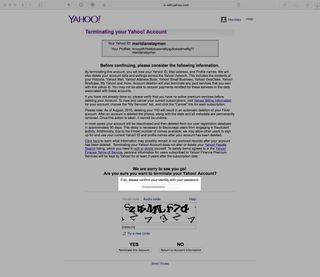How to delete your Yahoo! account and save data
If you've been following latest developments you may be wondering just how you can delete a Yahoo! account. Here's how you can do just that.

You must feel for fans of Yahoo! as the company has been in the news as of late for all the wrong reasons. Whether it's 500 million and then a further 1 billion accounts hacked, or a tool for government to search through email, it makes perfect sense for anyone to be concerned about a Yahoo! account.
We've compiled a quick guide to show you just how easy it is to remove your account and have your sensitive data deleted.
Remove your Yahoo! account
- Visit Yahoo!'s Terminating your Yahoo! Account page.
- Log in with your Yahoo! account.
- Type in your password to confirm your identity.

- Type in the CAPTCHA code to confirm your humanity.
- Click YES to delete your Yahoo! account. You'll see a confirmation page if you successfully deleted your account.
Stuff you should know
While deleting your account will hopefully protect you from potential attacks (if you haven't already been compromised), there are a few things you should note. First, terminating your Yahoo! account will remove access to the following:
- Yahoo! ID (which could, in the future, be claimed by someone else)
- Yahoo! Mail data
- Yahoo! Address Book data
- Yahoo! Small Business data
- Yahoo! GeoCities data
- Yahoo! Briefcase data
- My Yahoo! data
- HotJobs data
- Flickr account (including photo library, stats, and metadata)
Yahoo! says the deletion process takes about 90 days to complete. If you want your data scrubbed from Yahoo's servers sooner than that, you'll want to go through and delete your Yahoo! emails, Flickr photos, Yahoo! contacts, and more before completing the account termination process. We recommend you do this regardless.
Yahoo! also warns some of your information "might possibly remain" in its records even after you've deleted your account. (Yeah, we know that sucks.) To learn more about what data could be left behind, visit Yahoo!'s Data Storage and Anonymization support page.
Get the Windows Central Newsletter
All the latest news, reviews, and guides for Windows and Xbox diehards.

Rich Edmonds was formerly a Senior Editor of PC hardware at Windows Central, covering everything related to PC components and NAS. He's been involved in technology for more than a decade and knows a thing or two about the magic inside a PC chassis. You can follow him on Twitter at @RichEdmonds.
